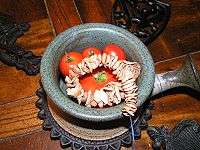Marasmius oreades
| Marasmius oreades en Jasa "fongueta" | |
|---|---|
| | |
| M. oreades the "fairy ring" mushroom. | |
| Scientific classification | |
| Kingdom: | Fungi |
| Division: | Basidiomycota |
| Class: | Agaricomycetes |
| Subclass: | Hymenomycetes |
| Order: | Agaricales |
| Family: | Marasmiaceae |
| Genus: | Marasmius |
| Species: | M. oreades |
| Binomial name | |
| Marasmius oreades (Bolton) Fr (1836) | |
| Marasmius oreades | |
|---|---|
|
| |
| gills on hymenium | |
|
cap is convex or umbonate | |
| hymenium is adnate | |
| stipe is bare | |
| spore print is white | |
| ecology is saprotrophic | |
| edibility: choice | |
Marasmius oreades, the Scotch bonnet, is also known as the fairy ring mushroom or fairy ring champignon. The latter name tends to cause some confusion, as many other mushrooms grow in fairy rings (such as the edible Agaricus campestris, the poisonous Chlorophyllum molybdites, and many others).
Distribution and habitat
Marasmius oreades grows extensively throughout North America and Europe in the summer and autumn (fall) (June - November in the UK), or year-round in warmer climates. It loves grassy areas such as lawns, meadows, and even dunes in coastal areas.
Description
It grows gregariously in troops, arcs, or rings (type II, which causes the grass to grow and become greener). The cap is 1-5 cm across; bell-shaped with a somewhat inrolled margin at first, becoming broadly convex with an even or uplifted margin, but usually retaining a slight central bump- an "umbo"; dry; smooth; pale tan or buff, occasionally white, or reddish tan; usually changing color markedly as it dries out; the margin sometimes faintly lined.[1]
The bare, pallid stem grows up to about 7cm by 5mm in diameter.
The gills are attached to the stem or free from it,[1] fairly distant (rather a distinctive character), and white or pale tan, dropping a white spore-print. The spores, themselves, are 7-10 x 4-6 µ; smooth; elliptical; inamyloid. Cystidia absent. Pileipellis without broom cells.[1]
This mushroom can be mistaken for the toxic Clitocybe rivulosa which lacks an umbo, is white to grey in color, and has closely spaced decurrent gills.
Edibility

Many mushroom connoisseurs are fond of M. oreades[1] and its sweet taste lends it to baked goods such as cookies. It is also used in foods such as soups, stews, etc. Traditionally, the stems (which tend to be fibrous and unappetizing) are cut off and the caps are threaded and dried in strings. A possible reason why this mushroom is so sweet-tasting is due to the presence of trehalose, a type of sugar that allows M. oreades to resist death by desiccation.[2] When exposed to water after being completely dried out, the trehalose is digested as the cells completely revive, causing cellular processes, including the creation of new spores, to begin again.
Ecological uses
Marasmius oreades can be used for the biological remediation of bismuth in polluted soils.[3]
References
- 1 2 3 4 Marasmius oreades (MushroomExpert.com)
- ↑ Marasmius oreades, the fairy ring mushroom, leprechaun. Tom Volk's Fungus of the Month for March 2003
- ↑ ^ Carmen Cristina Elekes; Gabriela busuioc. "The Mycoremediation of Metals Polluted Soils Using Wild Growing Species of Mushrooms". Engineering Education.http://www.wseas.us/e-library/conferences/2010/Corfu/EDUCATION/EDUCATION-04.pdf
External links
| Wikimedia Commons has media related to Marasmius oreades. |